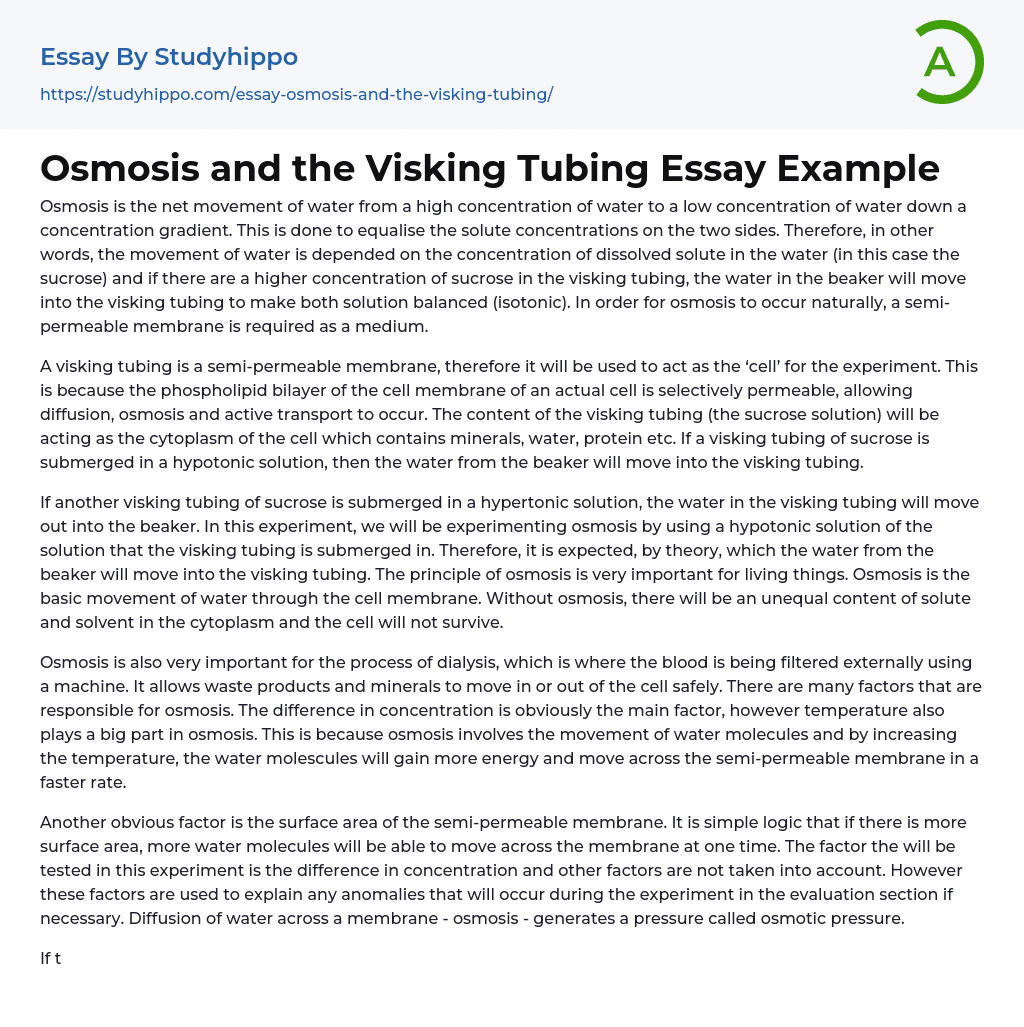Osmosis is the net movement of water from a high concentration of water to a low concentration of water down a concentration gradient. This is done to equalise the solute concentrations on the two sides. Therefore, in other words, the movement of water is depended on the concentration of dissolved solute in the water (in this case the sucrose) and if there are a higher concentration of sucrose in the visking tubing, the water in the beaker will move into the visking tubing to make both solution balanced (isotonic). In order for osmosis to occur naturally, a semi-permeable membrane is required as a medium.
A visking tubing is a semi-permeable membrane, therefore it will be used to act as the ‘cell’ for the experiment. This is because the phospholipid bilayer of the cell membran
...e of an actual cell is selectively permeable, allowing diffusion, osmosis and active transport to occur. The content of the visking tubing (the sucrose solution) will be acting as the cytoplasm of the cell which contains minerals, water, protein etc. If a visking tubing of sucrose is submerged in a hypotonic solution, then the water from the beaker will move into the visking tubing.
If another visking tubing of sucrose is submerged in a hypertonic solution, the water in the visking tubing will move out into the beaker. In this experiment, we will be experimenting osmosis by using a hypotonic solution of the solution that the visking tubing is submerged in. Therefore, it is expected, by theory, which the water from the beaker will move into the visking tubing. The principle of osmosis is very important for livin
things. Osmosis is the basic movement of water through the cell membrane. Without osmosis, there will be an unequal content of solute and solvent in the cytoplasm and the cell will not survive.
Osmosis is also very important for the process of dialysis, which is where the blood is being filtered externally using a machine. It allows waste products and minerals to move in or out of the cell safely. There are many factors that are responsible for osmosis. The difference in concentration is obviously the main factor, however temperature also plays a big part in osmosis. This is because osmosis involves the movement of water molecules and by increasing the temperature, the water molescules will gain more energy and move across the semi-permeable membrane in a faster rate.
Another obvious factor is the surface area of the semi-permeable membrane. It is simple logic that if there is more surface area, more water molecules will be able to move across the membrane at one time. The factor the will be tested in this experiment is the difference in concentration and other factors are not taken into account. However these factors are used to explain any anomalies that will occur during the experiment in the evaluation section if necessary. Diffusion of water across a membrane - osmosis - generates a pressure called osmotic pressure.
If the pressure in the compartment into which water is flowing is raised to the equivalent of the osmotic pressure, movement of water will stop. This pressure is often called hydrostatic ('water-stopping') pressure. This shows that osmosis will only occur to a certain point until water molecules will stop
moving across the membrane due to equal osmotic pressure (both solutions has equal concentrations). Therefore this experiment will investigate one factor that affects osmosis which is the concentrations.
- Bacteria essays
- Biotechnology essays
- Breeding essays
- Cell essays
- Cell Membrane essays
- Cystic Fibrosis essays
- Enzyme essays
- Human essays
- Microbiology essays
- Natural Selection essays
- Photosynthesis essays
- Plant essays
- Protein essays
- Stem Cell essays
- Viruses essays
- Acid essays
- Calcium essays
- Carbohydrate essays
- Carbon essays
- Chemical Bond essays
- Chemical Reaction essays
- Chemical reactions essays
- Chromatography essays
- Concentration essays
- Copper essays
- Diffusion essays
- Ethanol essays
- Hydrogen essays
- Organic Chemistry essays
- Osmosis essays
- Periodic Table essays
- Ph essays
- Salt essays
- Sodium essays
- Titration essays




